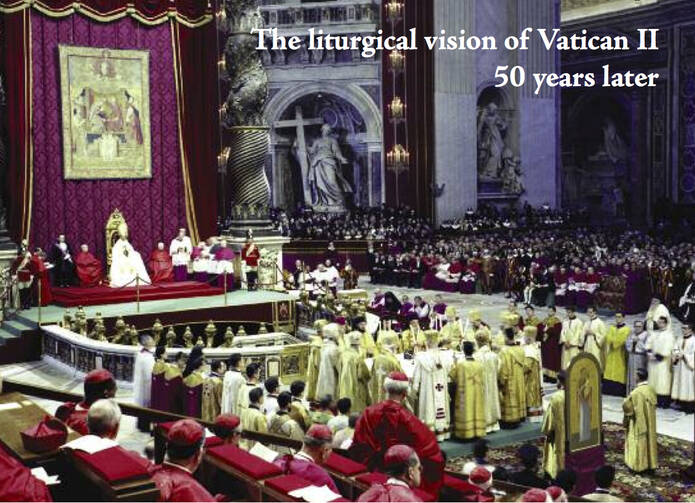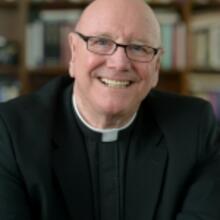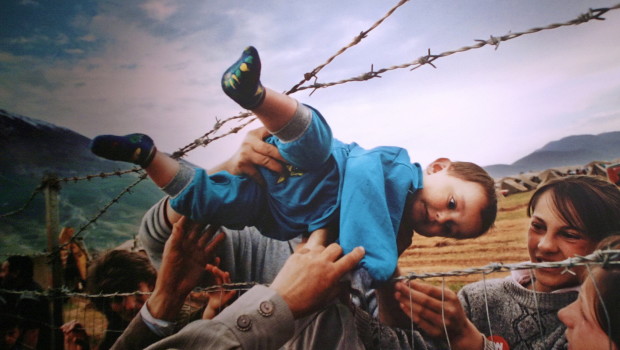It is not news that the liturgy has been a contested field in Catholic life over the past few decades. Opposition to liturgical reform began even before the conclusion of the Second Vatican Council, and increased from 1964 onward, when reforms like the use of English and the practice of the priest facing the people while presiding at the Eucharist began to be implemented.
In its most extreme form this rejection of Vatican II’s reform found a base in the traditionalist movement founded by Archbishop Marcel Lefebvre, which eventually split off in schism from the Catholic Church after he ordained bishops on his own. Part of that movement remained within the church and was greatly encouraged by Pope Benedict XVI’s motu proprio “Summorum Pontificum” ten years ago, which greatly liberalized permission to celebrate the traditional Latin Mass, now called the “Extraordinary Form.”
The opposition was not limited to this extreme, however. Another group characterized as the “Reform of the Reform” advocated modifications of the post-Vatican II reforms, such as a return to one Eucharistic Prayer (Prayer I, the Roman Canon) recited in Latin and in a low voice with the priest and people facing in the same direction (ad orientem). That movement’s most notable champion was Cardinal Joseph Ratzinger, but it had supporters among at least the past four prefects of the Congregation for Divine Worship and Discipline of the Sacraments : Cardinals Jorge Arturo Medina Estévez, Francis Arinze, Antonio Cañizares and (currently) Robert Sarah. These opposition movements also found support among some younger Catholics searching for a more transcendent experience of liturgy than they customarily experienced.
Pope Francis has definitively and unequivocally put his weight behind a liturgical movement.
In the meantime, various attempts at moving the reform forward, like proposed translations of the Psalter and the Roman Missal in the mid-90s by the International Committee on English in the Liturgy, were stalled or outright rejected by the Vatican. In addition, the Vatican also published a new document on translation (“Liturgiam Authenticam,”2001) that reversed the 1969 instruction on translation in a very traditional direction.
This restorationist movement in liturgy is being reversed by Pope Francis. A year ago the Vatican issued a rebuttal of opinions in favor of the “Reform of the Reform” put forward by Cardinal Sarah. Just this past year Francis established a commission to review “Liturgiam Authenticam.”(The outcome of their work has not yet been published.) The pope also replaced a good number of more traditional consultors to the Congregation for Divine Worship with individuals much more sympathetic to the Vatican II-inspired reforms.
And now, in a remarkably frank address to participants in National Italian Liturgical Week, Pope Francis has definitively and unequivocally put his weight behind a liturgical movement by declaring: “We can affirm with certainty and with magisterial authority that the liturgical reform is irreversible.” His use of the very strong phrase “magisterial authority” cannot be construed as casual. The paragraph with which his strong affirmation ends begins with the following:
But its importance can be found in the various aspects of the liturgical reform that Francis emphasizes. Let me name five.
First, he clearly affirms the importance of active participation in the liturgy, a participation that rejects participants assisting as “strangers and silent spectators” (“Sacrosanctum Concilium,” No. 48).
Second, he espouses the council’s own careful balance between respect of healthy tradition and legitimate progress (No. 23).
Third, he reiterates the necessity of long-term and patient liturgical education for both pastors and people.
Fourth, and this is a particularly significant theological emphasis, he speaks of the liturgy as the living presence of Christ, a presence that is manifested in multiple ways: the Eucharistic elements, the priest himself, the word proclaimed and the assembly gathered (No. 7). Francis’ emphasis on the multiple modes of the presence of Christ in the liturgy is particularly important because it leads him to say that the altar is “the center toward which our attention converges…the gaze of the praying people, priest and faithful, is oriented to the altar, convoked for the assembly around it [my emphasis].” I doubt very much that the pope was speaking loosely when he said “around” the altar. In other words I think it was a comment, albeit oblique, on those who want the priest to face “east.”
Finally, and certainly consistent with the fourth emphasis is Francis’ insistence that the liturgy is an action (“for the people, but also of the people” [emphasis in original]). He refers to his own homilies to drive home the insight that liturgy is not so much about doctrine in some abstract sense but about putting Christian life into action. The Eucharist in particular is not so much an act of private piety as it is the formation of the people of God.
It has been said that Francis is the first real Vatican II pope, having been ordained after the council concluded. He is showing that today by his strong affirmation of the way forward according to the liturgical reform that comprised such a significant element in that council’s outcome.
....
Taken from: https://www.americamagazine.org/faith/2017/08/28/five-reasons-pope-francis-embraces-vatican-ii-liturgy
In its most extreme form this rejection of Vatican II’s reform found a base in the traditionalist movement founded by Archbishop Marcel Lefebvre, which eventually split off in schism from the Catholic Church after he ordained bishops on his own. Part of that movement remained within the church and was greatly encouraged by Pope Benedict XVI’s motu proprio “Summorum Pontificum” ten years ago, which greatly liberalized permission to celebrate the traditional Latin Mass, now called the “Extraordinary Form.”
The opposition was not limited to this extreme, however. Another group characterized as the “Reform of the Reform” advocated modifications of the post-Vatican II reforms, such as a return to one Eucharistic Prayer (Prayer I, the Roman Canon) recited in Latin and in a low voice with the priest and people facing in the same direction (ad orientem). That movement’s most notable champion was Cardinal Joseph Ratzinger, but it had supporters among at least the past four prefects of the Congregation for Divine Worship and Discipline of the Sacraments : Cardinals Jorge Arturo Medina Estévez, Francis Arinze, Antonio Cañizares and (currently) Robert Sarah. These opposition movements also found support among some younger Catholics searching for a more transcendent experience of liturgy than they customarily experienced.
Pope Francis has definitively and unequivocally put his weight behind a liturgical movement.
Tweet this
In the meantime, various attempts at moving the reform forward, like proposed translations of the Psalter and the Roman Missal in the mid-90s by the International Committee on English in the Liturgy, were stalled or outright rejected by the Vatican. In addition, the Vatican also published a new document on translation (“Liturgiam Authenticam,”2001) that reversed the 1969 instruction on translation in a very traditional direction.
This restorationist movement in liturgy is being reversed by Pope Francis. A year ago the Vatican issued a rebuttal of opinions in favor of the “Reform of the Reform” put forward by Cardinal Sarah. Just this past year Francis established a commission to review “Liturgiam Authenticam.”(The outcome of their work has not yet been published.) The pope also replaced a good number of more traditional consultors to the Congregation for Divine Worship with individuals much more sympathetic to the Vatican II-inspired reforms.
And now, in a remarkably frank address to participants in National Italian Liturgical Week, Pope Francis has definitively and unequivocally put his weight behind a liturgical movement by declaring: “We can affirm with certainty and with magisterial authority that the liturgical reform is irreversible.” His use of the very strong phrase “magisterial authority” cannot be construed as casual. The paragraph with which his strong affirmation ends begins with the following:
And there is still work to do today in this direction [the reform begun by Pope Paul VI], in particular, rediscovering the reasons for the decisions taken with the liturgical reform, surmounting unfounded and superficial readings, partial reception and practices that disfigure it. It’s not about rethinking the reform by looking again at the choices, but of knowing better the underlying reasons, also through historical documentation, as well as to internalize the inspirational principles and observing the discipline that regulate it” [emphasis mine].Certainly Pope Francis is no fan of irresponsible experimentation or sloppy adaptation of the liturgy (as he witnesses strongly in his sober and simple celebrational style and choice of vestments), and there is nothing that is really new in this talk.
But its importance can be found in the various aspects of the liturgical reform that Francis emphasizes. Let me name five.
First, he clearly affirms the importance of active participation in the liturgy, a participation that rejects participants assisting as “strangers and silent spectators” (“Sacrosanctum Concilium,” No. 48).
Second, he espouses the council’s own careful balance between respect of healthy tradition and legitimate progress (No. 23).
Third, he reiterates the necessity of long-term and patient liturgical education for both pastors and people.
Fourth, and this is a particularly significant theological emphasis, he speaks of the liturgy as the living presence of Christ, a presence that is manifested in multiple ways: the Eucharistic elements, the priest himself, the word proclaimed and the assembly gathered (No. 7). Francis’ emphasis on the multiple modes of the presence of Christ in the liturgy is particularly important because it leads him to say that the altar is “the center toward which our attention converges…the gaze of the praying people, priest and faithful, is oriented to the altar, convoked for the assembly around it [my emphasis].” I doubt very much that the pope was speaking loosely when he said “around” the altar. In other words I think it was a comment, albeit oblique, on those who want the priest to face “east.”
Finally, and certainly consistent with the fourth emphasis is Francis’ insistence that the liturgy is an action (“for the people, but also of the people” [emphasis in original]). He refers to his own homilies to drive home the insight that liturgy is not so much about doctrine in some abstract sense but about putting Christian life into action. The Eucharist in particular is not so much an act of private piety as it is the formation of the people of God.
It has been said that Francis is the first real Vatican II pope, having been ordained after the council concluded. He is showing that today by his strong affirmation of the way forward according to the liturgical reform that comprised such a significant element in that council’s outcome.
....
Taken from: https://www.americamagazine.org/faith/2017/08/28/five-reasons-pope-francis-embraces-vatican-ii-liturgy






